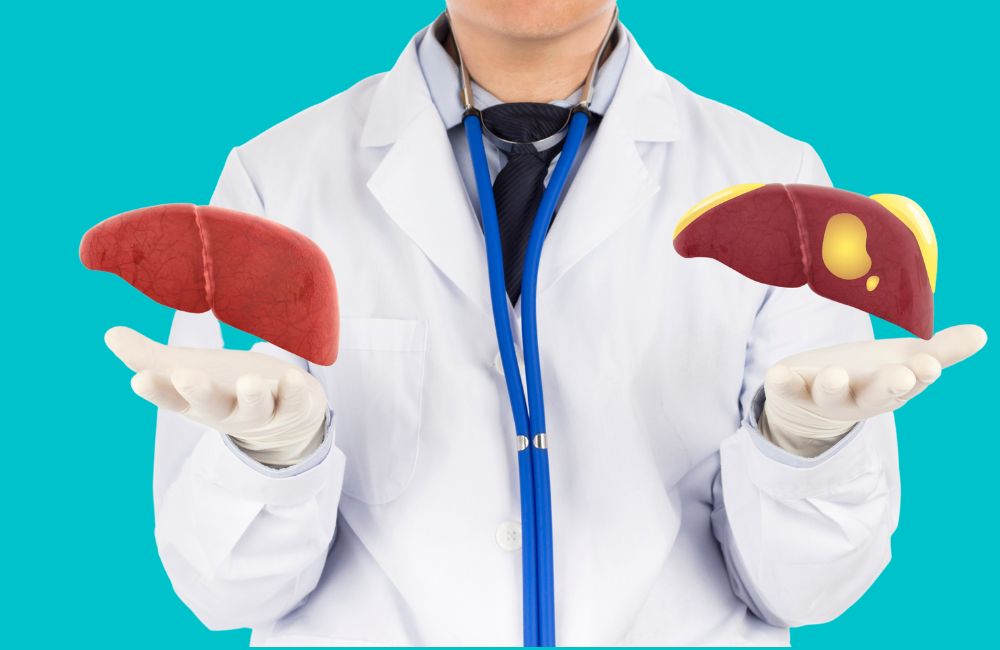Fatty liver disease (Hepatic Steatosis) is caused by abnormal accumulation of lipids particularly Triglycerides (TG) in the liver cells. Where do lipids come from? Lipids such as cholesterol, cholesteryl esters and triglycerides (TGs) are derived from the lipids in the diet or lipids that the body synthesises in the Liver.
Amino acids from proteins/glucose from carbohydrates are used to form lipids. These synthesised lipids can be stored, used in the liver or transported by a carrier protein called the VLDL (very low-density lipoproteins) to other tissues to be stored.
The body primarily stores lipids in specialised fat cells called adipocytes. These adipocytes have an almost unlimited capacity to store lipids in cell organelles called lipid droplets, which can grow to a very large size.
Although adipose tissue has essential functions in your body, excessive lipid storage can compromise cell function. A healthy liver contains a small amount of fat. It becomes a problem when fat reaches 5% to 10% of the weight of the liver.
What is Fatty Liver Disease?
Fatty liver is the excessive accumulation of lipids (Triglycerides and other Fats) in the liver cells called Hepatocytes. In some patients, fatty liver may be accompanied by hepatic inflammation and liver cell death (steatohepatitis).
Causes of Fatty Liver Disease
The pathophysiology is poorly understood but can be produced by several mechanisms including:
- Increased mobilisation of lipid from adipose tissue.
- Impaired removal or increased synthesis of fatty acids by the liver.
- Reduced formation or secretion of lipoproteins, carrier protein, the very low-density lipoproteins (LVDL).
Depending on the particular cause, one or more of these factors may be responsible.

The Classification of Fatty Liver Disease
There are three types of fatty liver vis:
-
Non-Alcoholic Fatty Liver Disease (NAFLD)
NAFLD occurs when fat builds up in the liver of people who don’t drink a lot of alcohol and there’s no inflammation or other complications.
NAFLD develops in 4 main stages. Most people will only ever develop the 1st stage usually without realising it. In a small number of patients, it can progress and eventually lead to liver damage if not detected and managed
The main stages are vis:
-
Simple Fatty Liver (Steatosis)
A harmless build of fat in the liver cells that may only be detected during tests for other conditions.
-
Non-Alcoholic Steatohepatitis (NASH)
A more serious form of NAFLD is where the liver becomes inflamed.
-
Fibrosis
Here the persistent inflammation causes scar tissue around the liver and nearby vessels, but the liver is still able to function normally.
-
Cirrhosis
The most severe stage occurs after years of inflammation. Here, the liver shrinks and becomes scared and lumpy. This damage is permanent and can lead to liver failure and Liver cancer.
It takes years for fibrosis or cirrhosis to develop. It is important to make lifestyle changes to prevent the condition from getting worse.
-
Alcoholic Fatty Liver Disease (AFLD)
AFLD is the earliest stage of alcohol-related liver disease. If there is no inflammation or other complications, the condition is known as simple alcoholic fatty liver.
-
Alcoholic Steatohepatitis (ASH)
ASH is a type of AFLD that results when there is a buildup of excess fat in the liver accompanied by inflammation. This is also known as alcoholic hepatitis.
-
Acute Fatty Liver of Pregnancy (AFLP)
AFLP is when excess fat builds up in the liver during pregnancy. It’s a rare but serious complication in pregnancy usually in the first three months. The exact cause is unknown, although genetics may be a reason the liver health usually returns to normal weeks after delivery.
If left untreated, it poses serious health risks to the mother and baby. With this diagnosis:
-
- The baby should be delivered as soon as possible.
- Follow-up care for several days after delivery is advised.

Risk Factors for Fatty Liver Disease
-
Heavy alcohol use
Heavy alcohol alters certain metabolic processes in the liver. It has been found that men who consume up to 40 to 80 grams of alcohol per day and women who consume 20 to 40 grams of alcohol per day over 10 to 12 years are at a higher risk of severe alcohol-related liver disease
Please note that 1 unit of alcohol =10mls or 8grams of pure alcohol.
-
Obesity
Obesity (excessive body mass index [BMI] and visceral obesity) is the most common and well-documented risk factor for NAFLD.
In fact, the entire spectrum of obesity, ranging from overweight(BMI 25- 29.9) to Obese class 1(BMI 30-35.9) to Obese Class 111(BMI- >40), is associated with NAFLD.
-
Type2 DM
There is a very high prevalence of NAFLD in individuals with T2DM. In fact, some studies have suggested that around one-third to two-thirds of diabetic patients have NAFLD. It is also important to remember the importance of the bidirectional association between NAFLD and T2DM.
-
Insulin Resistance
Here, cells don’t take up sugar in response to insulin hormone as in (Polycystic Ovarian syndrome (PCOS).
-
Dyslipidemia
High serum triglyceride (TG) levels and low serum high-density lipoprotein (HDL) levels are also common in patients with NAFLD.
-
Metabolic Syndrome
This is due to a combination of Diabetes + Obesity + high blood pressure.
-
Pregnancy
Fatty liver disease is an uncommon but potentially fatal complication that can occur in the third trimester or early postpartum period.
-
Side effects of Medications
Some types of Medications like Methotrexate and Tamoxifen can cause this disease.
-
Some Types of infections
Infections like Hepatitis C can lead to fatty liver disease.
-
Rare Genetic Conditions
Genetic conditions like Wilson disease or hypobetalipoproteinemia can also cause this disease.
Symptoms of Fatty Liver Disease
Most patients are asymptomatic. However, some have:
- Fatigue
- Malaise
- Right upper quadrant abdominal discomfort
- Liver enlargement (develops in about 75% of patients)
- Spleen enlargement may develop if advanced liver fibrosis is present and is usually the first indication that portal Hypertension has developed.
Patients with cirrhosis due to Non- Alcoholic Steatohepatitis (NASH) can be asymptomatic and may lack the usual signs of chronic liver disease.
Diagnosis of Fatty Liver Disease
Diagnosis starts from:
- History (presence of risk factors, absence of excessive alcohol intake)
- Serologic tests that rule out hepatitis B and C
- Ultrasound evidence of Steatosis or MRI-elastography with a fat fraction
- Liver biopsy
- The diagnosis of Non- Alcoholic Steatohepatitis (NASH) should be suspected in patients with metabolic syndrome (obesity, type 2 diabetes mellitus, hypertension, or dyslipidemia) and in patients with unexplained laboratory abnormalities suggesting liver disease
Differentiating simple Steatosis from NASH can be difficult and elevated liver enzymes are not a sensitive predictor for identifying NASH.
The presence of metabolic syndrome as well as elevated ferritin increases the likelihood that a patient has NASH rather than simple Steatosis.
Further, clinical scoring systems such as:
- The FIB4 score.
- NAFLD fibrosis score calculator.
- Laboratory NASH FibroSure® (can identify patients at risk for fibrosis and thus those more likely to have NASH and be at risk for progression to cirrhosis)
- Aspartate aminotransferase [AST] to platelet ratio index [APRI]) in NASH is usually < 1.

Treatment of Fatty Liver Disease
The management of NAFLD should consist of
-
Treating liver disease
Liver disease is often treated as well as the associated metabolic comorbidities such as obesity, hyperlipidemia, IR, and T2DM.
-
Lifestyle Intervention
Lifestyle modification consists of:
-
- Diet
- Exercise
Exercise alone in adults with NAFLD may prevent or reduce HS, but its ability to improve other aspects of liver histology remains unknown.
-
- Weight loss
Weight loss of at least 3%-5% of body weight appears necessary to improve Steatosis, but a greater weight loss (7%-10%) is needed to improve the majority of the histo-pathological features of NASH, including fibrosis.
-
Drugs
- Metformin improves liver enzymes and insulin resistance but does not significantly improve liver histology.
- Pioglitazone improves liver histology in patients with and without T2DM with biopsy-proven NASH. Therefore, it may be used to treat these patients. Risks and benefits should be discussed with each patient before starting therapy.
- Vitamin E (a-tocopherol) administered at a daily dose of 800 IU/day improves liver histology in non-diabetic adults with biopsy-proven NASH and therefore may be considered for this patient population. Risks and benefits should be discussed with each patient before starting therapy
-
Surgery
-
Bariatric Surgery
Foregut bariatric surgery can be considered in otherwise eligible obese individuals with NAFLD or NASH.
-
Liver Transplant
NASH and cryptogenic cirrhosis are highly prevalent among patients awaiting liver transplants and, in fact, NASH is on a trajectory to become the most common indication for liver transplants in the United States.
Conclusion
The liver has an amazing ability to repair itself. If alcohol is avoided or weight lost, it’s possible to reduce liver fat and inflammation and reverse early liver damage. Thus the best way to avoid fatty liver disease is to do the things that maintain overall health:
- Stay at a healthy weight. If you have overweight/obese, lose weight gradually.
- Exercise regularly.
- Limit your alcohol consumption.
- Take medications as prescribed.

